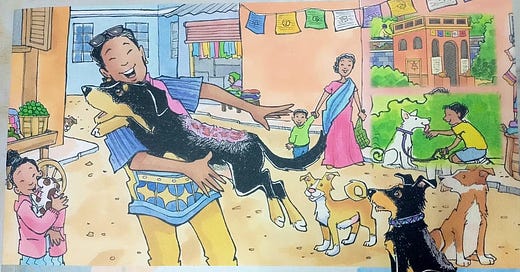Welcome to the sixteenth in a series of interviews with authors who write books about animal rights and related matters. Julie Palais retired from the National Science Foundation (NSF) at the end of 2016 and began her “encore career” in animal welfare. She completed a Post-Graduate Certificate in International Animal Welfare Ethics and Law (IAWEL) from the University of Edinburgh (2017) and a Master’s of Science (MS) in Anthrozoology (2019) at Canisius College in Buffalo, New York. Julie is particularly interested in the link between animal cruelty and human violence and is one of the first to examine data collected (since 2016) by the FBI on animal cruelty in the US. Julie is the author of a children’s book about an abused street dog called Sathi: The Street Dog from Kathmandu, Nepal.
You were a scientist (glaciologist) whose field was climate change research and in a new career you are presently completing a master’s degree program in animal law at Lewis & Clark. What role did your career in science and now law play in informing your understanding of the present status of animals?
During my career as a science administrator for the National Science Foundation, my husband and I became involved in a dog rescue organization for Golden Retrievers, our breed of choice. I also started doing pet therapy with one of my dogs, at nursing homes, assisted living facilities, hospitals, and a hospice in-patient center. Once social media became popular, I saw the value in using platforms like Facebook to share information about dogs who needed rescue and rehoming. Over time, I learned about the many issues related to companion animal welfare, such as breed discriminatory legislation, the no-kill movement, dog behavior, and animal cruelty, just to name a few. When we moved to our farm in the country the thing that captured my interest was the plight of outdoor dogs, many of whom lived chained to dog houses or in small pens, instead of inside with their families. After my first trip to Nepal, the plight of free-roaming street dogs became a topic of great interest to me.
One area where there is significant overlap between what I was doing in the field of glaciology and my recent animal law education is the topic of industrial animal agriculture and global climate change. As the Antarctic Glaciology Program Director at the U.S. National Science Foundation, I was instrumental in advancing the study of ice cores, which has helped scientists develop a better understanding of the composition of the atmosphere in the past, from the analysis of gas bubbles in ice cores. The study of ice cores is one of the primary ways that scientists know that the carbon dioxide and methane composition of the air in the past was much lower than it is today.
What I find surprising is that until my recent course in industrial animal agriculture, with Professor Joyce Tischler at the Centre for Animal Law Studies, I didn’t even realize how much the greenhouse gases in the atmosphere are connected to the raising of animals for meat and dairy. I am embarrassed to say that even I had the misconception that animal agriculture played a very small part in the atmospheric composition of these gases. I have since learned that the raising of animals for meat and dairy does play an important role in the level of greenhouse gases in the atmosphere. I believe that this is something that needs much more visibility in the earth science community.
What prompted you to write Sathi The Street Dog from Kathmandu, Nepal?
The book Sathi is based on a true story of a street dog who was abused by a woman in Kathmandu, Nepal. The dog was living in the woman’s neighborhood. She found the dog to be a nuisance and one day she threw boiling water on the back of the dog to make it go away. The dog was badly injured and when my friend, who was feeding the dog every evening, came upon the injured dog, she took a video of the suffering dog and sent it to me. Eventually, the dog was taken to a dog treatment center, and the dog’s wounds were treated. The dog, who came to be called Max, lived for a time with a man in Kathmandu who taught him how to live inside with a family and how to walk on a leash and be a good family pet. Money was raised so that Max could fly to Toronto, Canada, where he was adopted by a loving family.
There were several reasons that I had for writing the book. One reason was to try and prevent other street dogs from being abused in the future. I thought that if people read the book and empathized with the situation that the dogs found themselves in, then maybe they would think twice before abusing a dog in the future. Another reason that I had for writing the book was so that I could change the way that the story ended. One of the morals of the story is that it is not necessary for every dog that is rescued in Nepal to be adopted by a family in another country. Many people think that the only good home for a street dog is one that is outside of Nepal. I do not agree with that opinion and it is also not a sustainable solution for every street dog living in Nepal. It costs a lot of money to send a dog to North America or Europe and it is impossible for every street dog to find a new home in another country. That is why I wanted to make the point that street dogs in Nepal can find good homes with local Nepali families. In addition, I wanted to show people that Nepali street dogs make good family pets, and it is not necessary to adopt an expensive purebred puppy from a dog breeder.
What do you seek to accomplish with Sathi?
I decided to write the book about Sathi, as a way to raise awareness about the animal cruelty that exists toward street dogs and is very common in Nepal. Street dogs are frequently harmed and abused in various ways in Nepal but very little research exists about the reasons for the abuse. It has been my hypothesis for quite a while, that many people don’t like the dogs in their neighborhoods either because they are fearful of the dogs or because they find them to be a nuisance. I wanted to get people to think about the situation from the point of view of the dogs. Not everyone is a dog lover, however people need to understand that it is not ok to hurt dogs and that they should look for other ways to resolve the problems that exist in their neighborhoods. In short, my goal in writing the book was to get people to stop abusing street dogs and instead think of them as potential family pets.
Interestingly, I didn’t realize until just recently that the way that I had chosen to write the book, by telling the story from the “first person” (i.e. the dogs) point of view, was exactly the same way that Anna Sewell had written the book about the horse named Black Beauty. Amazingly, for a person like me who loves horses, I had never actually read the book and I only had a vague idea what the book was about. I am currently actually listening to the audiobook and really enjoying it.
How would describe people’s attitude toward animals in Nepal?
The treatment of animals in Nepal depends on many different factors and is impacted by where people live (city or in a rural area), the type of animal in question, people’s religious beliefs, their economic condition, and their level of education. Nepal is a very poor and very rural country, and many people, even those living in the cities, live close to animals. In addition to the street dogs that roam throughout most cities, there are other types of domestic animals (chickens, ducks, goats, and other livestock) that are often seen along the side of the road, that are bought and sold every day in the marketplace. Cows are the national animal and in this predominantly Hindu country, they are prohibited from being slaughtered. It is not uncommon to see abandoned cows along the side of the road (or in the road). This is especially true of male cows who don’t produce milk and who cannot be slaughtered for meat. On the other hand, buffalo (water buffalo) are used for both milk and meat.
One issue that has been of great concern for me, ever since I started visiting Nepal, is the way that farm animals, like cows, buffalo, and goats are tethered in Nepal. Almost everyone ties up their animals using a very short rope and the animals have very little ability to move around. Animals are used by people for milk and meat, or they are used for work. Even dogs are seen as protectors of the home and business and very few people allow their dogs inside their house. Those who aren’t allowed to roam freely are often chained up on very short chains or are confined to a small metal dog kennel outside the home, with, if they are lucky, a piece of carpet for bedding.
A large number of people that I have encountered care about animals in the same way that many people do in other parts of the world. This is especially true of most children. On the other hand, there is a real lack of knowledge about animal welfare and a lot of misinformation about how to care for animals. There are so many problems it is hard to even know where to start. There is also very little government support or assistance provided when it comes to managing the large populations of street dogs that exist in cities and throughout the country.
How different is it working for animals in Nepal than in the United States?
One very big difference between the USA and Nepal is that there are virtually no laws in Nepal that expressly protect the welfare of animals. There are a few privately run animal shelters for dogs and what are called gaushalas for abandoned cows, but the notion of a municipal shelter, run by the government does not exist in Nepal. The privately run dog shelters are mostly there to provide for the street dogs. Therefore, private owners who no longer want a family pet usually just abandon them on the street. Since many/most of these animals are not sterilized they end up contributing to the homeless dog population when they have puppies.
In addition, there are many free-roaming (owned/unowned and stray) street dogs and feral dogs in cities and rural areas throughout the country. Rabies is also endemic throughout Nepal and many stray dogs have no vaccinations. As a result, rabies is still a real threat in many parts of the country and people are afraid of the dogs roaming on the streets. When dogs develop illnesses and skin conditions, such as mange, that make them look ugly and scary, many people ignore the dogs and do things to make them go away. This is what happened to the dog in my book Sathi.
As part of my recently completed animal law master’s degree program at Lewis and Clark Law School, I developed an initiative called SAVE Nepal. SAVE stands for Save Animals and Value the Environment. The goal of SAVE Nepal is to introduce the field of animal law into the law school curriculum in Nepalese law schools and to educate the next generation of lawyers in the field of animal law. Eventually, the idea is for these newly trained lawyers to draft new laws and amend existing ones to be more protective of animals.





